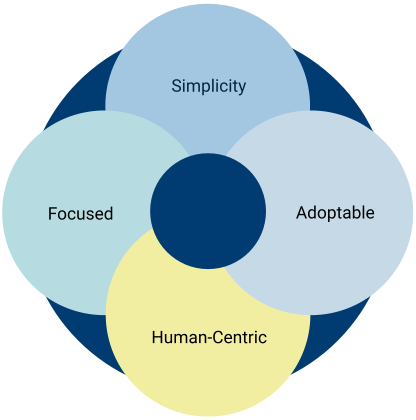The Tulip Solution Credo provides guiding principles towards Composability Solutions.
The Solution Credo principles guide solution design and development which every Citizen Developer should "live by". Citizen Developers that follow these principles naturally result in solutions that are more sustainable, more intuitive, and more valuable for the operator.
Tulip Solution Credo principles:
- Simplicity
- Adoptable
- Human-Centric
- Focused

Simplicity
Einstein said “Everything should be made as simple as possible, but not simpler.” All great solutions and designs have this trait, balancing complexity of the problem with a “simpler” solution. Simplicity makes Tulip solutions easy to understand, easy to maintain, easy to change and most importantly more adoptable.
What does Simplicity mean in practice?
- Simple Tulip Table Model
- Tulip Tables used to store either Physical Artifacts (e.g. Equipment, Batches, Stations, etc...) or Operational Artifacts (e.g. Defects)
- Each App uses only a handful (< 6) of Tulip Tables
- Minimal reliance on Table Queries/Aggregations
- Minimal/Simple Triggers at App-Level and Step-Level
- Interacts with 3rd-Party System of Record in Real-Time (Where Applicable)
- An Operator that is new to the app is able to use it for a happy-path use case with zero training.
- A second Citizen Developer that is new to the app can understand how it works and can support fixes and enhancements.
Adoptable
What does Adoptable mean in practice?
- Customer has taken ownership of applications built during and after the Onboarding process.
- Customer Citizen Developers have been the primary app builders.
- Customer Citizen Developers have Published apps and are using them on the Shop Floor.
- Customer is actively developing app solutions for new use cases, and continuing to iterate on existing solutions.
- Published apps are actively growing in usage and value.
Human-Centric
Tulip is a Frontline Operations Platform, it is human centric and the content we create has to serve humans or frontline operators.
What does Human-Centric mean in practice?
- The Application Serves the Operator (not the other way around)
- User Experience that is Intuitive & Efficient
- Uses Barcode Readers & Connected to IIoT devices (where applicable.)
- Minimize human-error & minimize keystrokes
- Vision
- Pick To Light
- Device integration
- Operator presented with KPIs relevant to the task at hand.
- “Are we doing well?”
Focused
Focus on what needs to be done to gain productivity, there is a difference between must-haves and nice-to-haves.
What does Focused mean in practice?
- The Solution is split into separate apps by a combination of:
- Persona
- i.e. App(s) for Operator vs. Shop Floor Supervisor vs. Quality
- Use Case / Process
- Area: Where is the work being performed?
- Time
- (e.g. a process that by design takes course over several stages and/or shifts might be best implemented via sepearate apps)
- Persona
- The Solution implemented satisfies the Business Objectives
Additional Resources
The Solution Credo is also discussed in Tulip University at 'Tulip Solution Design'

